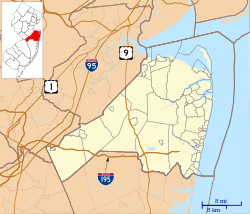Sandy Hook Proving Ground
| Sandy Hook Proving Ground | |
|---|---|
| United States | |
| Sandy Hook Near Atlantic Highlands, New Jersey in United States |
|

Entrance (1911)
|
|
|
Location of the Proving Ground on Sandy Hook
|
|
| Coordinates | 40°28′2.852″N 73°59′57.203″W / 40.46745889°N 73.99922306°WCoordinates: 40°28′2.852″N 73°59′57.203″W / 40.46745889°N 73.99922306°W |
| Type | Proving ground |
| Site information | |
| Owner | United States Department of War |
| Operator |
|
| Controlled by | U.S. Ordnance Department |
| Open to the public |
Yes, with restrictions |
| Condition | Poor |
| Adjoining facility | Fort Hancock |
| Site history | |
| Built | August 7, 1874 |
| Built by |
|
| In use | 1876-1919 |
| Fate | Facilities relocated; buildings abandoned |
| Test information | |
| Other tests | Artillery |
| Remediation | None |
|
Fort Hancock and the Sandy Hook Proving Ground Historic District
|
|
| Visitation | 6,021,713 (2014) |
| Part of | Fort Hancock and the Sandy Hook Proving Ground Historic District (#80002505) |
| Significant dates | |
| Designated NHL | December 17, 1982 |
| Designated CP | April 24, 1980 |
The Sandy Hook Proving Ground was a military facility along the Atlantic coast of New Jersey established by the Secretary of War on August 7, 1874, to serve as the United States Army's first proving ground for the testing of ordnance and materiel. The facility was located at Sandy Hook, a narrow coastal spit of land, approximately 6 miles (9.7 km) in length and 0.5 miles (varying between 0.1 and 1 miles) wide, in Middletown Township in Monmouth County. The facility was operated in conjunction with the adjoining Fort Hancock. Essentially abandoned in 1919 for a larger facility, the area was left to degrade and most of the structures still remain today. The proving ground and parts of Fort Hancock are now property of the National Park Service and mostly closed to the public.
The Civil War, just ten years earlier, had introduced several new innovations in weaponry. Rifled cannon fired pointed-nosed projectiles farther and faster than cannonballs and ironclad warships with mounted guns that could destroy the walls of a traditional fort. The Army needed a place to test its own new weapons. The Sandy Hook Peninsula met the Army's needs for an experimental testing area for heavy ordnance and was on land that was already government owned, which provided flat and open areas for testing. Sandy Hook was distant enough to be far from towns but close enough to large cities and transportation by water. In 1874, most of Sandy Hook was covered with holly and cedar forests and tidal marshes which still cover a large percentage of it today. Most of the Federal development of the Hook was concentrated on the northern end. A huge granite five-bastioned fort near the northern end of the Hook, dominated the area, even though it was still incomplete and was destined never to be completed. In addition to the fort, there was the Engineer's wharf, erected on the western shore in 1857, to accommodate the fort's construction, the Engineers' shop and quarters, and the Sandy Hook Life-Saving Station, established on the northeastern shore in 1854. It was decided to lay out the Proving Ground on the eastern margin of the Hook, just below the southeast bastion of a Civil War-era fort. The firing range was to extend southward along the beach with the facilities consisting of the wooden gun platforms of the proof battery, a bombproof, a frame instrument house, and sand butts on the firing range.
...
Wikipedia

